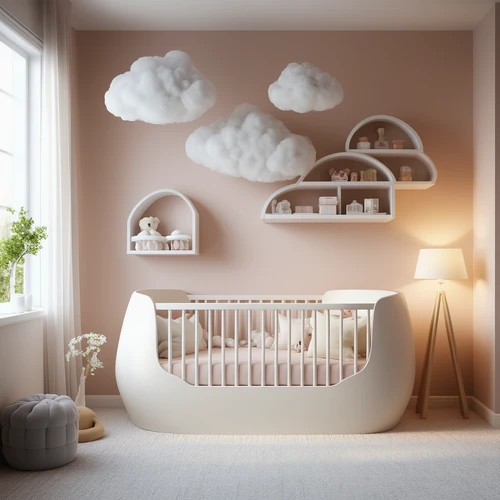Choosing the Right Color Palette: Colors set the tone of a nursery. Soft pastels like blush pink, mint green, or airy sky blue are traditional choices that promote tranquility. For a modern twist, consider muted neutrals such as sage, taupe, or pale gray; they create a calm backdrop that lets your décor accents pop.
Tip: Use a single accent color sparingly—on a headboard, a mobile, or a rug—to tie the room together without overstimulating the little one.
Lighting Matters: A layered lighting plan is essential. Combine natural light, a soft bedside lamp, and adjustable task lighting at the crib. Dimmer switches allow you to create a cozy atmosphere for bedtime stories or a bright environment for diaper changes.
Storage & Organization: Clutter disrupts a serene space. Floating shelves, built‑in cubbies, and baskets in durable fabrics keep essentials within reach yet hidden from sight. Labeling bins in matching colors helps the baby grow with a sense of order.
Safety First: All furniture should have rounded corners, be firmly secured to the wall, and be free of loose parts. Keep cords and wires out of reach. Install outlet covers and a baby gate at the door if the room is accessible to other children.
Safety Tip: Ensure the crib meets the latest safety standards—no loose slats, and a firm mattress that fits snugly. Use breathable, fitted sheets that do not tear when the baby moves at night.
Texture Play: Different textures create sensory interest and comfort. Choose a plush rug, a knitted throw, or a tactile wall hanging that the baby can touch safely during tummy time.
Personal Touches: Incorporate family photos in soft frames or hand‑painted signs. A small bookshelf with a selection of board books encourages early literacy and offers a corner for family storytelling.
Consider Future Flexibility: A nursery should evolve with the child. Furniture that can be rearranged, such as a mobile crib or a convertible playard, keeps the space adaptable for toddlers and eventually a child’s bedroom.
Eco‑Friendly Choices: Aim for low‑VOC paints, sustainably sourced wood, and organic fabrics. Non‑toxic materials create healthier air quality for both baby and parents.
Eco Tip: Reuse a crib frame from a previous child; refurbish it to meet current safety codes rather than purchasing an entirely new unit.
Lighting for Milestones: A soft night light helps the baby feel secure during midnight feedings, while a brighter lamp at the table supports developmental milestones like coloring or building blocks.
Final Touch – Greenery: A small potted plant placed out of reach adds a natural aesthetic, improves indoor air quality, and offers a subtle sensory experience without any risk.
Conclusion: A thoughtfully designed nursery balances aesthetics, safety, and practicality. By carefully selecting colors, ensuring proper lighting, and prioritizing sustainable, flexible furniture, parents can create a nurturing environment that grows with the child—supporting development, comfort, and lifelong love of learning.


